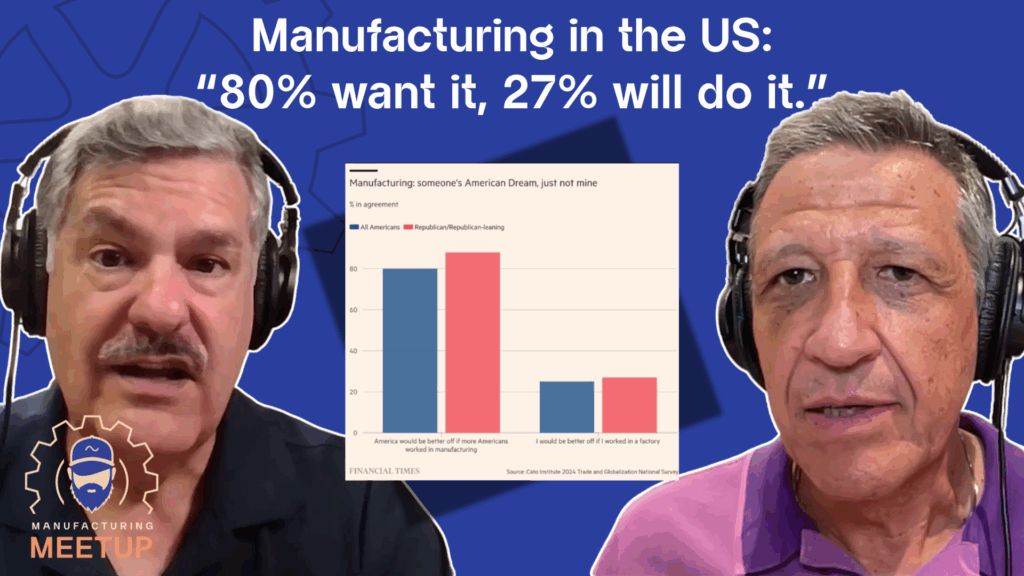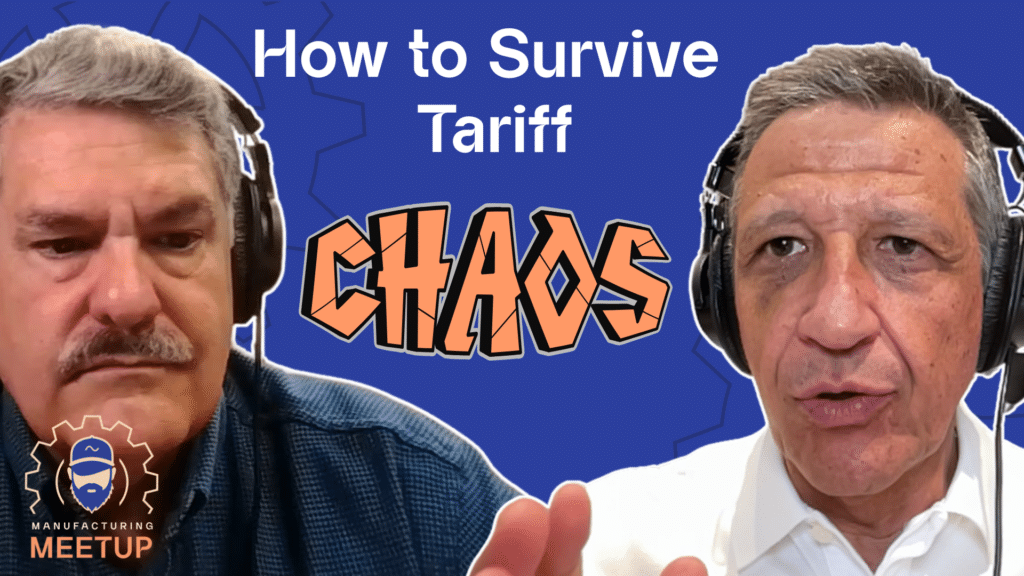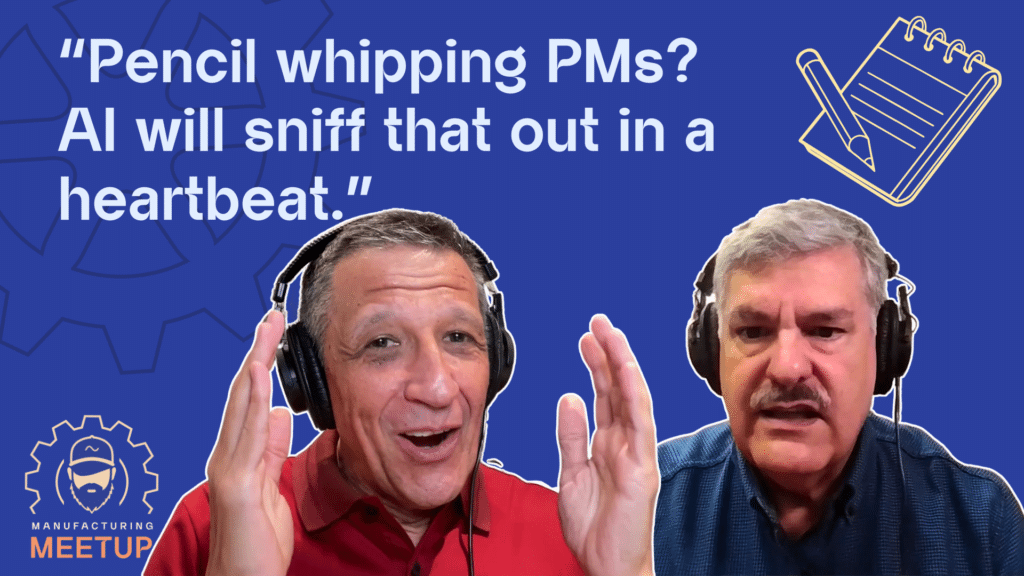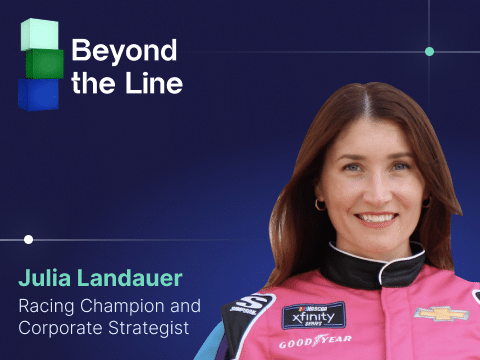Best Root Cause Analysis Methods?
Ever feel like you’re constantly putting band-aids on the same problems in your plant? Ed and Alvaro tackle one of your most requested topics: root cause analysis. They share real shop floor stories, including a $6,000 gearbox that didn’t need replacing and why throwing more glue at a packaging problem isn’t always the answer.
Whether you’re tired of the blame game between maintenance and operations or just want practical tools you can use tomorrow, this episode delivers. From the simple “five whys” method to how AI helps uncover the root cause of problems, we cover what actually works on the plant floor.
What You’ll Learn:
- Why root cause analysis isn’t just another step – it’s a complete game changer
- The difference between using a shotgun vs. a sniper rifle approach to problem solving
- How to get maintenance and operations working together instead of against each other
- Real examples of problems solved in weeks instead of months
- How AI tools are taking root cause analysis to the next level
Mentioned in this show: Kepner-Tregoe
Let’s keep the conversation going:
Email us at mmu@augury.com
Find us on The Endpoint: endpoint.augury.com
Download the full podcast here:
Apple
Spotify
Amazon Music
iHeart Radio
YouTube Music (formerly Google Play)
Full Transcript
Ed Ballina (00:20)
Great! Well, hello manufacturing buddies! I’m Ed Ballina.
Alvaro Cuba (00:26)
Hello guys, Alvaro Cuba here.
Ed Ballina (00:29)
And welcome to another Manufacturing Meet Up podcast today, you’ll see this after a Memorial Day but we’re recording this the day the week before and I am where we’re gonna start a new idea here alvar and I will wear different hats at all of these events because You know when you work in a beverage facility see this you have used to have to wear baseball hats. So Alvaro is sporting our very, very attractive and fashionable manufacturing meetup. I am actually wearing a Navy SEAL baseball cap. It’s SEAL Team 2. And a very good friend of mine who is a commander, retired with the Navy SEALs, gave me this as a gift and something a treasure. So with that being said, this is the show. Go ahead.
Alvaro Cuba (01:13)
Yeah, no, I love that custom. You know, when I came to the US, it’s basically a great US practice. So when I came, every game or every activity basically comes with a hat. Yes. So I love it. We’ll prepare guys because we’ll bring some crazy stuff.
Ed Ballina (01:41)
Just a way to have a little bit of fun and spice it up a little bit. So this is, as you know already, the podcast where Alvaro and I kick back. We have guest speakers. We talk about our challenges on the shop floor, funny things that have happened to us throughout the years. And trust me, we got more where that came from. We’ve got tons of stories, many, many, many more. So anyway, just a quick close up.
Happy, happy Memorial Day to all of you and a special thank you to our servicemen and women. So, Alvaro, what have we been doing that’s been fun?
Alvaro Cuba (02:13)
Yes. Yeah, it’s been fun and a lot going on. And one of the topics that we choose for today was based on feedback from you guys in root cause analysis and how it works in the plant, when it fails, when it not. So we’ll talk a lot more about that.
I hope that you like it and you bring your ideas as well.
Ed Ballina (02:49)
I always want to hear from you. So let’s get started.
Alvaro Cuba (03:25)
So this was feedback from you guys, and we received some similar questions. We decided to do this, ask us a question. So we selected three of them. And we’ll start with the first one, that it’s a little bit about overall why root cause analysis, what are the tools and the methods.
some examples that simple ways that we make it work. let me start with the why. first is a systemic approach and is not an isolation. So this is not something that you do because this is the step one of a bigger process. You do info, you get the data, you look for solutions, but then you need to test and then you need to implement.
So needs to be part of it. It’s to determine the underlying causes, the true causes that if you go straight and fix them, fix the entire problem versus a band-aid or a symptom that you fix now and tomorrow fails again and fix the next and that. Second is, it’s very efficient. It happens, I’m sure to you and it happened to Ed and I, when you’re in the plant and you go…oh, that’s failing. Go do this. Go do that. Without a proper root cause analysis, you spend a lot of dollars, time, effort, headaches, and resources that you’d thrown away until you do the root cause analysis. So this is efficient and also puts everyone on the same page. Because you talk this, the other talk that, when you do root cause analysis, then we all agree on what’s the problem, and then we all can work together on a solution.
Just a simple example to get you thinking, you have a headache and it’s repeating. You use root cause analysis in your daily life. You think, what time of the day I have it? What activity was I doing? What’s the pattern? Was I stressed or not? Once you gather a little bit of data, then you come to the conclusion, every time it’s because I’m dehydrated or it’s a stress every time I’m in stress. So that’s just an example. So, yes, allergies. This is the time for allergies. Okay. Give us some methods and applications.
Ed Ballina (06:26)
So, so team, there’s lots and lots of tools. As Alvaro just said, you’re probably utilizing these mental processes already in your everyday life, right? But one of the easiest methods to implement is the five whys, right? And it’s, if you have a problem, you ask why. And when you get an answer, you ask why again, until you get to the point where you can’t go any further. Because one of the problems with, with troubleshooting is many times we are looking at a symptom and we try to cure the symptom. Let’s go back to the headache analogy, right? A headache, right, has to do with blood pressure in the brain. I’m not a doctor, but you know, you can treat the symptom. You can take Tylenol, Advil, whatever, and the headache goes away. But if to Alvaro Cuba’s point, that headache continues, all you’re doing is masking it and you’re not dealing with the actual root cause. So the five “whys” are really simple to execute and very easy to learn. Lots and lots of other stuff out there. We learned a lot, frankly, from the Japanese. I was an early convert to Deming and SPC. You’ve got such tools in there. Ishikawa diagram, cost-effect relationship, Pareto’s, which force you to focus on the things that provide the biggest return. And here’s one, common sense.
Alvaro Cuba (07:52)
Yes.
Ed Ballina (07:52)
Ask your operators, go to the floor and say, hey Joe, do you remember the last time this happened? And it’s amazing, they are a wealth of encyclopedic knowledge. Sometimes they’re just waiting for you to ask them the question. And now you just gained another buddy or supporter, right? Sometimes it’s less common, but we’ve all heard of tribal knowledge, right? Tribal knowledge is real, right? Our people develop all these cause and effect relationships in their mind. That’s what makes good operators great operators. The problem is all tribal knowledge isn’t true. Some tribal knowledge, they’re like urban myths. So take that for what it’s worth. I’m going to tell you, and for the record, I’m not getting paid for this as an endorsement, but analytical troubleshooting training for me by Kepner Tregoe was such an foundational element in my career. I learned out of Proctor and Gamble two years into my career and I have used those concepts for longer than I can remember. I’ve taught it to my kids. When I worked at PepsiCo, I brought Kepner Tregoe in to train my plant managers and all that. So anyway, big deal.
Alvaro Cuba (09:03)
Yeah. And every continuous improvement, TPM, Six Sigma, 5S, you name it, everyone starts with root cause analysis.
Ed Ballina (09:19)
Absolutely. So I’ll share a little an example with you. When I was providing technical engineering support for the pulp mill at P &G, they were having a problem in some of their pulp wash. And one pulp washer in specific that there is a takeoff roll that when the pulp, it’s a pulp washer, sucks the water out of the pulp. And then you have a roll that takes the pulp and essentially takes it off the roll. On this one particular installation, those those rollers takeoff rollers would break. There were vanes in them that would break. They would cost, you know, 20 hours of downtime and a lot of money. I applied analytical troubleshooting concepts to it. And what we found is that was the only place in the process where we actually mixed water that had been squeezed out of chlorinated pulp as a dilution for the pulp that was coming off that washer. Well, I learned about chlorine stress corrosion cracking.
The temperature was perfect and it was the only place in the process that had that makeup water being used. And as soon as we changed to a material that was resistant to chlorine stress corrosion cracking, the problem went away. If I would have shotgunned that, it would have been months and years before I figured it out. So that was really impactful for me.
Alvaro Cuba (10:41)
I had one with open flaps in a cartoner. And the solution immediately, more glue. Yeah, fix it. And then the glue start getting into the product. And at the end, just said, okay, this is not the right way. So we started and we went to applicator, the carton.
Ed Ballina (10:52)
Yeah. Turn up the glue.
Alvaro Cuba (11:10)
The pollution. And at the end, it was the pollution. What it had changed is the ventilator stopped working and it was more dust. And the dust with the glue made the glue not that effective. Small. Let me leave you with one, that it always worked for me.
Human relations. Every time you are working with someone and you have disagreements, tense discussions, misunderstandings, apply root cause analysis. Immediately you will understand that and you will say it’s communication, it’s expectations, it’s skills, it’s what? Then you solve it and your work is going to be completely different.
Ed Ballina (11:43)
Absolutely. I’m gonna mention that to my wife as soon as I get home. She may tell me, hopefully it’s working for you, okay. So my buddy Alvaro Cuba shared this technique honey, she’ll say, hey, here’s a mirror, let’s start with that. You look in the mirror.
Alvaro Cuba (12:15)
I’m applying it by the way. I’m applying it already.
Okay, yes, we’ll do that between you and I.
Ed Ballina (12:29)
Well, compare. But wait a minute, not to take away from that example, but Alvaro, if it was me, I would have just tied up another glue nozzle, dude. What’s the big deal? Another hose, another glue nozzle? I would get those flaps to spray hard. Now you get consumer complaints because you couldn’t peel this stuff off of the package.
Alvaro Cuba (12:48)
Yes. OK, question two. Let’s go.
Ed Ballina
So, you know, when we, when we, talk about, you know, improvement efforts and all that at some point in time, people can get into the blame game, right? Especially between production and maintenance. No, why did we start up late? Well, we started up late because maintenance was still on the machine. Well, no, not really. I gave it to you 45 minutes ago, but your operators were in the break area. They weren’t ready to fire up. And these conversations go on all the time. You know what? At the end of the day.
You really, really two things that I think really matter your data. So your data has to be clean because data doesn’t lie. Right. There needs to be one version of the truth because that clears the smoke away. Secondly, you have to always when you have, learned this long time ago, when you have competing forces, right, the immovable force against, you know, the infinite force. Right. The only way to solve that is to reconcile to the higher good.
And the higher good, if I’m pushing production and somebody’s pushing maintenance, their higher good is what are your plant results? I don’t care who, I’m not interested in this functional battle between you because at the end of the day, your bonus and our compensation and our results are based on what the whole plant delivers, not what one isolated department. Doesn’t mean that one isolated department can drive it one way or another, it can, but at the end of the day, in these plants, we all win or lose.
And the last piece I leave there is clarity of roles. Okay. Because if, if, if everybody’s doing something, nobody’s doing it. It’s your, you don’t have single point accountability and doesn’t mean you can’t have team accountability, but be clear who’s responsible for that. If I am maintenance, okay. One of my expectations is when I get to that machine, that machine is clean. Okay. I should not start by, you know, clearing the mess that frankly operations should have dealt with.
On the flip side, you don’t expect after the job is done to have operations come in and clean up the grease and the rags that the maintenance folks left behind, right? We’re in this together folks. So, Alvaro, I’m sure you’ve got…
Alvaro Cuba (15:02)
Let me throw a couple in there. The famous what’s in it for me. No. If we can clarify that from the beginning and the mechanics learn what the operators do to help them and vice versa, and what each one gains of this collaboration, then they are going to be much more open because it’s going to impact their personal life, it’s going to impact the way they manage the teams. And when that happens, you start learning and then you start growing and then you can share that even at home in your community. And the other is we were talking about this is not an isolation. As Ed said, I also had a great experience with the Japanese, with TPM.
We don’t need to reinvent the wheel. All the TPM approach for meetings, for instance. You have the meeting every hour, every shift, every day. What you do in those meetings, you have the formats, the graphs. One graph tells more than a thousand words. You all get into the room. So all that is exactly for that. If you use that environment and that practice, and do the root cause analysis as the first step, then it naturally brings the different people together. I had an example, a clear example with gum wrappers and all the blaming, the mechanics. Well, to tell you, the machine was stopping every minute or less. So imagine the life of that operator and the risk of to safety, the quality, everything all around. And the mechanics were saying, no, no, it’s your setup. It’s your cleaning. You are not lubricating properly. You haven’t done your SOPs or your base condition is off. The operators were saying, no, no, it’s the machine that breaks down. It’s overheating. you are not doing a good PM, the parts are wearing. And nobody came for a lot of time, no solution. And on top of what you just said, it was permanent fighting and all that until we brought all of them together and we start doing the root cause analysis. Okay, everything you say, everything the other part says. For now it’s this part and the other part. And then we went, what else? And to everyone’s surprise, it became, we also have problems with the materials. Okay, so bring procurement. yes. And this part and other, bring the supplier. And then the quality, bring quality. And then we had the four or five, no?
And it was amazing when they did all the root cause analysis and used the tools that Ed was describing. They found that the lubrication in the product to make it to go very fast was not appropriate and wasn’t working well. And with the supplier, they develop a new one. Once they put that, the jump in the machine was from one minute almost to 30 minutes. And then it allowed 30 minutes to people to think, to see, to watch and all that. In three months, I think, or something like that, we were in four hours. Compare the life.
Ed Ballina (19:15)
Wow. And that is so, the life and as a person involved in a project like that, how rewarding is that, right? When you can actually say, here’s where we were and here’s where we are and we can tell you exactly what we did to get there. Those wins are elusive many times in our plants. yeah. No, really is amazing. I just recently was invited to participate with one of my bottlers in a Kaizen event to help reduce the overfills on a bottle line. And I was impressed. There were about 12 people in the room. We had people from maintenance, from engineering, from QC, obviously from production. The VP of operations was there, including some finance people. I was like, wow, let me tell you, we spent eight hours together. Okay. We spent another couple of hours on the phone.
Within about a week and a half, they reduced the overfills on that line by 45%. And last time I heard from them, because they didn’t stop, they’ve continued having the meetings, they were down probably close to 60, 65 % reduction in their waste from that line. And that’s what you can accomplish when you put these teams together. And you look at this from a lot of different angles. It really is, it’s incredible what you can accomplish. And then you start creating these relationships that are really, really powerful.
And I’ve seen some people participate in those and before you know it, they develop an interest maybe if you’re an operator and getting it to maintenance and now they have a relationship with the maintenance folks and that cross-functional work is really, really amazing.
Alvaro Cuba (20:57)
Actually, it is a first step in TPM. You get the plant manager and all his staff with all the operators in the line and the mechanics and everyone, and they all together break the line out, clean it, inspect it, bring it back. And to Ed’s point, not only the benefit in the line, but the benefit in the entire team, community, the plant, the communications.
Ed Ballina (21:30)
And the leadership from the top is, so important. Oh, one thing I wanted to mention for this whole overall. Right. Why do you want to do root cause analysis? Folks, it’s the difference between using a shotgun versus a sniper’s rifle. Okay. When you have a problem in your machine and you start tweaking knobs and changing settings, right. I have seen machines get to a point where they just won’t run.
Alvaro Cuba (21:34)
It’s so important.
Ed Ballina (21:57)
Because we tried everything and we forget to go and do what we did. Isn’t it much better to… Yeah, because they know better, right? You come in and shift time, what you find is people will tell you, I don’t want to do root cause analysis because it’s painful, man, right? You got to spend a lot of time in a conference room talking to people and asking questions and getting numbers. And I’m like, I’d rather spend six hours in a conference room gathering information, right?
Alvaro Cuba (21:59)
Yeah. or every shift changing that because they know better.
Ed Ballina (22:27)
Getting the root cause down to two or three probable causes and then go out and execute, than spend eight hours playing with the settings on this machine, watching it puke product back and forth and have to go back to centerline anyway to begin the process. So this approach is much more efficient. And yes, it can be painful because you have to do some due diligence, right? And gather the information, but you have tons of tools that can help you take that information and make it into actionable insights.
Alvaro Cuba (22:56)
Okay, great, great insights. Let’s move to the question three. So we are in the AI revolution and in the AI times. So how that change or helps or whatever the root cause analysis. Ed.
Ed Ballina (23:19)
Yeah. So I, you know, we could spend like several podcasts on this topic. So I’ll try to close it, close it here in reasonable time. So a couple of things, how can it help specifically root cause analysis? One is early detection. Okay. Many times you’re going to use root cause analysis discussions and you know the thing failed, you know when it failed, but if you have good AI and good predictive maintenance, you can start watching the failure curve. Most of the time, mechanical failures follow a bathtub curve. They start increasing in risk and vibration until they a pinch point where literally in two hours, the thing will destroy itself. Well, early detection, you may be able to find out this thing is starting to fail two weeks or two months before it does. That’s incredibly powerful. You also start developing these cause and effect relationships and learnings that maybe you weren’t aware of before, right?
Hey, every time we run green labels on that labeler, my vibrational level goes up. Maybe that says there’s something odd with that raw material, right? And there was another one that I wanted to mention here. It also provides for more bandwidth, right? As a human being, how much data can we analyze in a root cause analysis? AI can help you sift through all that, right? And just give you the true actionable insights. And then I’ll share one example where I saw AI really saved the day. So we had an Augury vibration sensor, a handheld unit, the Auguscope. And the Pepsi plant in Tampa had a gearbox on their palletizer that was failing and they ordered a new one, 6K, right?
Because they thought for sure that was the problem. They put the Auguscope on it and it comes back, you know, what is it, 48 hours later and says, you’ve got loose mounting on the gearbox. They went in, they sure enough found loose bolts. They tightened the gearbox, the gearbox problem went away. They saved six grand. But here’s what is the real interesting part of this. Had they just, had they taken the old gearbox off and put the new gearbox on, the problem would have gone away because they would have tightened it to the base and all along they would have thought the problem was with that old gear box might have got thrown away, which was perfectly fine. So a little example that saved them six grand. And you know what? There’s lots of examples for that out there in our facilities. Alvaro.
Alvaro Cuba (25:59)
Yeah, you mentioned Augury. I just had the opportunity to see what they call Process Navigator. It’s part of their production process health. And you and I know if we are talking about one machine is one thing. If we are talking about a line, and you need to calibrate everything in the line with all the moving parts and all the changing things, it becomes really, really difficult. And there is where AI comes to help because how it manage a sheer amount of data, this is the perfect example. So, yeah, and this Process Navigator starts taking the goals from the plant. So starts from the goals. And then goes to the other end and takes all the process data, all of that, equipment, process, data. It takes the historicals and it also compares to other machines and other performances and puts it all, analyzes in the AI processors and it comes with predicting outcomes.
It’s what you were saying. It’s moving like in maintenance. It’s moving from preventive to predictive. In this case, it also starts moving and it says, hey, this temperature is starting to move. You better adjust in real time and before it fails, which is a huge step forward. And it allows you to optimize settings
Ed Ballina (27:26)
That’s impressive. Right. Right. It’s big.
Alvaro Cuba (27:55)
adjusted in real time, even the capabilities, even when the goals change or the conditions in the plant change, it immediately recalculates and tells you what are the new settings that you need and to put there. And even when you have conflicting goals. So all of that, I was really, really impressed. I want to go back to the plant and have these tools. Imagine our lives.
Ed Ballina (28:24)
I got to get my eye on that. That’s impressive. Alvaro, Alvaro, they would not be able to contain us. It’s probably a good thing we didn’t have these tools, you know.
Alvaro Cuba (28:41)
without, with us out of the plant otherwise.
Ed Ballina (28:46)
Yeah, I was lucky to have some adult beverages with a very good friend of mine who’s a plant director here locally for one of the major beverage companies. And we were just talking about the experiences that we had in the plants. And just to the point that you were making, the times where you were up in grease to your elbows, this particular plant director implemented TPM in his plant and I’ve mentioned him before his name is Todd Kelly. I admire him. He’s a great friend I really got blown away when I walked by his labeler during a TPM event and this man was up to his nose in grease and pieces of in glue and all that, he was in there with his people cleaning the machine, right? And that he leads from the front right and you learn so much as a leader if you engage with the floor, engage with the equipment, show them that you’re willing to get your hands dirty. That buys you so much credibility. It’s huge.
Alvaro Cuba (29:45)
Absolutely. Absolutely. And one last thing, root cause analysis, help with AI for safety and quality. Check it out. It’s huge, huge difference using sensors, videos, and many other tools to help you to improve significantly both of them. Okay. So I think time for a wrap up.
Ed Ballina (29:58)
Yep, I think time for the wrap up is here. We’re going to leave you with one thing each, right, that you can go execute right now. I’m going to tell you why, why, why. Okay. Go do why, why, why. And you’re going to get some value out of that. There are obviously more sophisticated methodologies, but start with that.
Alvaro Cuba (30:36)
Yeah, bring a cross-functional team. Pick one, even two different functions. Do it tomorrow.
Ed Ballina (30:45)
Do it tomorrow, I love it. So I think that brings us to the wrap up, Alvaro.
Alvaro Cuba (30:53)
Yeah, well, thank you for joining us. I think this root cause analysis is very important. So don’t forget, not in isolation, it’s part of a big thing. Think about the benefits for every one of you, every one of your colleagues and everyone that works in the plant. And with AI now, this is not about replacing the people, it’s augmenting their skills and making it much more, it’s great for the plant, but it’s great for the people as well. So it’s a win-win-win.
Ed Ballina (31:35)
And remember nobody likes to work on a crappy line, right? So, this our canals can help we have the tools for that It’s not a root canal anymore people. Okay, it’s not a root canal anymore
Alvaro Cuba (31:40)
Yes. And now we have the tools for that. Yes. Great. Please, hear Ed, we all suffer for that. We don’t need to suffer in the plant. We have the root cause analysis, AI and much more. Okay folks, so it’s time to wrap up and thank you very much for joining as always. And thank you for your questions. It allows to do these AMA episodes and please chime in, send.
Continue to send your questions, your ideas, your thoughts, and grab a drink and join us. If you like this, like us in YouTube or leave us a review in iTunes. And more important, tell your pals.
Ed Ballina (32:38)
Yes, tell your pals even you’re not so great pals Okay, I mean we don’t judge we we’re not judgmental. We’ll take any viewer. anyway
Alvaro Cuba (32:44)
Ha ha ha. Yeah, do your root cause analysis with them and then bring them to the show.
Ed Ballina (32:52)
And they bring it with you. So if you want to keep this conversation going, can email us at mmu.augury.com. You can find us on the endpoint. It’s the free online community for manufacturing groups like us. It’s at endpoint.augury.com. We’ll have those links in the show note episodes as well. And happy Memorial Day peeps, even though it’ll be a little late.
We appreciate you and God bless the USA.
Alvaro Cuba (33:25)
God bless you.
Meet Our Hosts

Alvaro Cuba
Alvaro Cuba has more than 35 years of experience in a variety of leadership roles in operations and supply chain as well as tenure in commercial and general management for the consumer products goods, textile, automotive, electronics and internet industries. His professional career has taken him to more than 70 countries, enabling him to bring a global business view to any conversation. Today, Alvaro is a strategic business consultant and advisor in operations and supply chain, helping advance start-ups in the AI and advanced manufacturing space.

Ed Ballina
Ed Ballina was formerly the VP of Manufacturing and Warehousing at PepsiCo, with 36 years of experience in manufacturing and reliability across three CPG Fortune 50 companies in the beverage and paper industries. He previously led a team focused on improving equipment RE/TE performance and reducing maintenance costs while improving field capability. Recently, Ed started his own supply chain consulting practice focusing on Supply Chain operational consulting and equipment rebuild services for the beverage industry.




